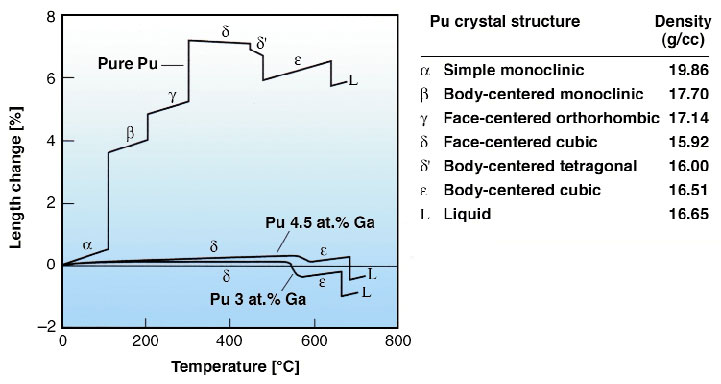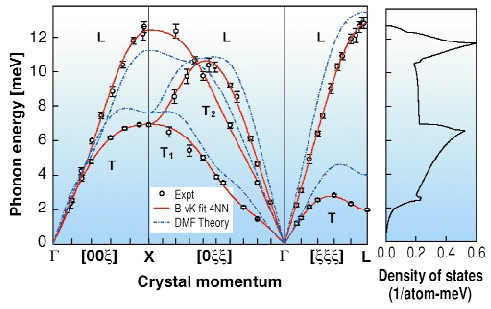- Home
- Users & Science
- Scientific Documentation
- ESRF Highlights
- ESRF Highlights 2003
- High Resolution and Resonance Scattering
- Catching Phonons in Plutonium
Catching Phonons in Plutonium
Phonon dispersion curves (PDCs) in plutonium (Pu) and its alloys have defied measurement for the past few decades since the discovery of this element in 1941. This is due to a combination of the high thermal-neutron absorption cross section of plutonium and the inability to grow the large single crystals (with dimensions of a few millimeters) necessary for inelastic neutron scattering. These limitations have recently been overcome by using a tightly focused undulator X-ray microbeam scattered from single-grain domains in polycrystalline specimens. This experimental approach has been applied successfully to map the complete PDCs of an fcc d-Pu-Ga alloy using the high resolution inelastic X-ray scattering (HRIXS) capability on ID28.
Pu is well known to have complex and unique physico-chemical properties [1]. Notably, the pure metal exhibits six solid-state phase transformations with large volume expansions and contractions along the way to the liquid state: ![]()
![]() ß
ß ![]()
![]()
![]()
![]()
![]()
![]() '
' ![]()
![]()
![]() liquid. Unalloyed Pu melts at a relatively low temperature ~ 640°C to yield a higher density liquid than that of the solid from which it melts (Figure 14). PDCs are key experimental data to the understanding of the basic properties of Pu materials such as: force constants, sound velocities, elastic constants, thermodynamics, phase stability, electron-phonon coupling, structural relaxation, etc.
liquid. Unalloyed Pu melts at a relatively low temperature ~ 640°C to yield a higher density liquid than that of the solid from which it melts (Figure 14). PDCs are key experimental data to the understanding of the basic properties of Pu materials such as: force constants, sound velocities, elastic constants, thermodynamics, phase stability, electron-phonon coupling, structural relaxation, etc.
 |
|
Fig. 14: Transformations in Pu to different crystal structures are accompanied by very large volume changes. Alloying with Ga or Al avoids the transformation to |
The complete PDCs for an fcc Pu-0.6 wt% Ga alloy are plotted in Figure 15, and represent the first full set of phonon dispersions ever determined for any Pu-bearing materials. The solid (red) curves are calculated using a standard Born-von Kármán (B-vK) force constant model. An adequate fit to the experimental data is obtained if interactions up to the fourth-nearest neighbours are included. The dashed (blue) curves are recent dynamical mean field theory (DMFT) results by Dai et al. [2].
 |
|
Fig. 15: Phonon dispersions along high symmetry directions in |
The elastic moduli calculated from the slopes of the experimental phonon dispersion curves near the ![]() point are: C11 = 35.3 ± 1.4 GPa, C12 = 25.5 ± 1.5 GPa and C44 = 30.53 ± 1.1 GPa. These values are in excellent agreement with those of the only other measurement on a similar alloy (1 wt% Ga) using ultrasonic techniques as well as with those recently calculated from a combined DMFT and linear response theory for pure
point are: C11 = 35.3 ± 1.4 GPa, C12 = 25.5 ± 1.5 GPa and C44 = 30.53 ± 1.1 GPa. These values are in excellent agreement with those of the only other measurement on a similar alloy (1 wt% Ga) using ultrasonic techniques as well as with those recently calculated from a combined DMFT and linear response theory for pure ![]() -Pu .[2]
-Pu .[2]
Several unusual features, including a large elastic anisotropy, a small shear elastic modulus C', a Kohn-like anomaly in the T1[011] branch, and a pronounced softening of the [111] transverse modes are found. These features can be related to the phase transitions of plutonium and to strong coupling between the lattice structure and the 5f valence instabilities. The HRIXS results also provide a critical test for theoretical treatments of highly correlated 5f electron systems as exemplified by recent dynamical mean field theory (DMFT) calculations for ![]() -plutonium.
-plutonium.
The experimental-theoretical agreements shown in Figure 15 in terms of a low shear elastic modulus C', a Kohn-like anomaly in the T1[011] branch, and a large softening of the T[111] modes give credence to the DMFT approach for the theoretical treatment of 5f electron systems of which ![]() -Pu is a classic example. However, quantitative differences remain. These are the position of the Kohn anomaly along the T1[011] branch, the energy maximum of the T[111] mode s and the softening of the calculated T[100] branch near the X point, which is not observed experimentally. These differences are significant and thus provide a framework for refined theoretical treatments. Systematic HRIXS experiments as a function of temperature and concentration in the fcc Pu-Ga alloys are underway.
-Pu is a classic example. However, quantitative differences remain. These are the position of the Kohn anomaly along the T1[011] branch, the energy maximum of the T[111] mode s and the softening of the calculated T[100] branch near the X point, which is not observed experimentally. These differences are significant and thus provide a framework for refined theoretical treatments. Systematic HRIXS experiments as a function of temperature and concentration in the fcc Pu-Ga alloys are underway.
References
[1] S.S. Hecker, Challenges in Plutonium Science, Los Alamos Sci, 26, 290 (2000).
[2] X. Dai et al., Science 300, 953 (2003).
Principal Publication and authors
J. Wong (a), M. Krisch (b), D.L. Farber (a), F. Occelli (a), A.J. Schwartz (a), T-C. Chiang (c), M. Wall (a), C. Boro (a), and R. Xu (c), Science, 301, 1078 (2003).
(a) Lawrence Livermore National Laboratory (USA)
(b) ESRF
(c) University of Illinois at Urbana-Champaign (USA)



